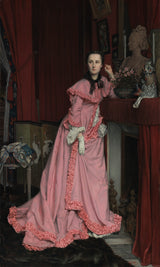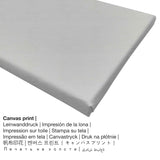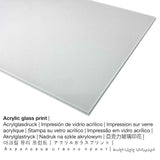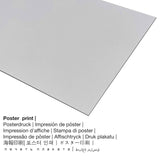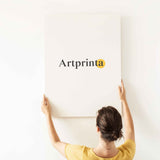James Tissot, 1866 - Eserese nke Marquise de Miramon, née Thérèse Feuillant - ọmarịcha nka.
Ụtụ gụnyere. Mbupu gbakọrọ na ndenye ọpụpụ.
Ihe ị kwesịrị ịma gbasara ihe nka ihe karịrị afọ 150
Ihe nka nke oge a Portrait of the Marquise de Miramon, née Thérèse Feuillant was painted by the male painter James Tissot in 1866. The 150 Emere ọmarịcha ihe osise dị afọ na nha: 128,3 x 77,2 cm (50 1/2 x 30 3/8 na) e tekwara ya na ọkara mmanụ na kwaaji. N'oge a, ihe osise na-etolite akụkụ nke Ụlọ ihe ngosi nka nke J. Paul Getty mkpokọta nka. Nkà ọgbara ọhụrụ ngalaba ọha a na-enye ọrụ nka site n'ikike nke Ụlọ ihe ngosi nka nke J. Paul Getty.Ebe E Si Nweta nke ihe osise:. E wezụga nke ahụ, nhazi ahụ bụ Eserese na nwere akụkụ ruru nke 9: 16, nke pụtara na ogologo bụ 45% mkpụmkpụ karịa obosara. The painter, caricaturist James Tissot was an artist, whose art style was primarily Realism. The artist was born in 1836 ma nwụọ na afọ nke 66 n'afọ 1902.
Nye iwu ihe kacha amasị gị
Maka ngwaahịa ọ bụla anyị na-enye nha na ihe dị iche iche. Anyị na-ahapụ gị ka ịhọrọ n'ime ụdị ndị a:
- Mpempe akwụkwọ ederede (akwa akwa akwa): The poster is a printed cotton canvas with a slightly roughened finish on the surface, which resembles the actual version of the work of art. Please keep in mind, that depending on the absolute size of the poster print we add a white margin 2 - 6cm round about the artwork, which facilitates the framing with your custom frame.
- Mbipụta enyo acrylic: The acrylic glass print, which is often labelled as a plexiglass print, will change the original work of art into amazing home decoration and forms a good alternative option to dibond and canvas fine art replicas. The artwork is printed with modern UV direct print machines. With an acrylic glass art print sharp contrasts plus small image details become more identifiable because of the delicate tonal gradation in the picture.
- Mbipụta kanvas: The printed canvas, which should not be mistaken with a canvas painting, is an image printed on an industrial printer. What is more, canvas print creates a homelike and pleasing impression. Your canvas of your favorite artpiece will allow you to transform your new fine art print into a large work of art as you would see in a gallery. Hanging your canvas print: A canvas print has the great advantage of being relatively low in weight, which means that it is easy to hang your Canvas print without extra wall-mounts. A canvas print is suitable for all kinds of walls.
- Mbipụta ọla (aluminium dibbond): An Aluminium Dibond print is a print with a true depth effect. For the Direct Aluminium Dibond print, we print your selected artpiece right on the surface of the aluminum composite. The white & bright components of the artwork shine with a silky gloss but without the glare. Colors are luminous, details are crisp.
Disclaimer: We try the best we can to depict the art products as exact as possible and to demonstrate them visually. Although, the tone of the printed materials and the printing might differ somehwat from the presentation on your device's monitor. Depending on your settings of your screen and the quality of the surface, not all color pigments will be printed 100% realistically. Bearing in mind that all art prints are printed and processed by hand, there might also be minor variations in the size and exact position of the motif.
Nkọwa ngwaahịa
| Nkewa ngwaahịa: | ezi nka mmeputakwa |
| Mmeputakwa: | dijitalụ mmeputakwa |
| Usoro mmepụta: | UV kpọmkwem obibi |
| Production: | German mmepụta |
| Stockdị ngwaahịa: | a na-achọ |
| Ngwaahịa were: | ihe ndozi mgbidi, ime ụlọ |
| Nhazi onyonyo: | nhazi ihe osise |
| Njikwa oyiyi: | 9: 16 |
| Mmetụta akụkụ: | ogologo bụ 45% mkpụmkpụ karịa obosara |
| Akwa ngwaahịa dị: | Mbipụta kwaaji, mbipụta ọla (aluminium dibond), mbipụta akwụkwọ mmado (akwụkwọ kwaaji), mbipụta enyo acrylic (nwere ezigbo mkpuchi iko) |
| Nhọrọ nke akwa akwa n'elu etiti ihe ndọtị (mbipụta akwa akwa): | 50x90cm - 20x35", 100x180cm - 39x71" |
| Mbipụta iko acrylic (nwere ezigbo mkpuchi iko) dị iche iche: | 50x90cm - 20x35", 100x180cm - 39x71" |
| Mpempe akwụkwọ mmado (akwụkwọ kwaaji) nha: | 50x90cm - 20x35" |
| Nha aluminom dibond (ihe aluminom) nha: | 50x90cm - 20x35" |
| Nhazi nke nka nka: | na-enweghị etiti |
Ozi ahaziri na nka
| Akụkụ nka: | "Portrait of the Marquise de Miramon, née Thérèse Feuillant" |
| Nhazi nka: | sere |
| Category: | nkà nke oge a |
| oge: | 19th narị afọ |
| Emepụtara n'afọ: | 1866 |
| Afọ nka: | karịa afọ 150 |
| Ihe osise izizi: | mmanụ na kwaaji |
| Akụkụ ihe osise izizi: | 128,3 x 77,2 cm (50 1/2 x 30 3/8 na) |
| Ụlọ ihe ngosi nka / mkpokọta: | Ụlọ ihe ngosi nka nke J. Paul Getty |
| Ebe ebe ngosi nka: | Los Angeles, California, Njikota Obodo Amerika |
| URL webụ: | www.getty.edu |
| Ụdị nka nka: | ngalaba ọha |
| Site n'aka: | Ụlọ ihe ngosi nka nke J. Paul Getty |
Nchịkọta nkenke nke onye na-ese ihe
| Aha onye nka: | James Tissot |
| Aha ndi ozo: | James Jacques Joseph Tissot, James Joseph Jacques Tissot, James Tissot, ja.s tissot, טיסו ג'יימס, j. j. tissot, Tissot James, J. Tissot, Tissot J. J., Tissot J. James, Tissot James Jacques, Tissot James-Jacques-Joseph, tissot joseph jacques, j.j. tissot, joseph jacques tissot, Tissot Jacques Joseph, Tissot Jacques-Joseph, Tissot James Jacques Joseph, Tissot, Tissot James Joseph Jacques, jacques joseph tissot |
| Gender: | nwoke |
| Obodo onye nka: | French |
| Ọrụ: | painter, caricaturist |
| Mba onye si: | France |
| Nhazi nke onye nka: | omenkà nke oge a |
| styles: | Ihe ngosi |
| Ndụ: | 66 afọ |
| Afọ ọmụmụ: | 1836 |
| Nwuru: | 1902 |
© Copyright - Artprinta.com (Artprinta)
Artwork information by The J. Paul Getty Museum website (© - Ụlọ ihe ngosi nka nke J. Paul Getty - Ụlọ ihe ngosi nka nke J. Paul Getty)
Costumed in the latest style and surrounded by fashionable decorative objects, the Marquise de Miramon wears a rose colored, ruffled peignoir, or dressing gown. Around her neck are a black lace scarf and a silver cross. Reflecting the new European fascination with Japanese art, behind her is a Japanese screen depicting cranes on a gold ground, and on the mantelpiece are several pieces of Japanese ceramics. The needlework on the Louis XVI stool indicates that the subject is a noble woman of leisure, and the eighteenth-century terracotta bust suggests her husband's aristocratic heritage.
Thérèse -Stephanie-Sophie Feuillant (1836-1912) was from a wealthy bourgeois family. She inherited a fortune from her father and in 1860 she married Réne de Cassagnes de Beaufort, Marquis de Miramon. She stands in the Château de Paulhac, Auvergne, her husband's family seat.
Tissot painted many fashionable women during his career, but he held this work in particularly high regard. In 1866, he wrote to request, and received, permission to borrow the painting and submit it to the Paris World Fair, where it was seen in public for the first time. The family kept this letter from Tissot along with a swatch of the Marquise's pink velvet gown. Today, the fabric swatch and the painting are in the collection of the Getty Museum and the letter is part of the collection of the Getty Research Institute.

